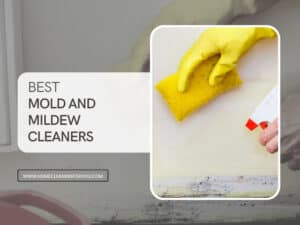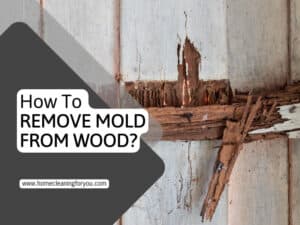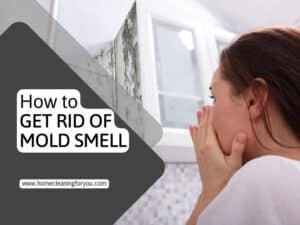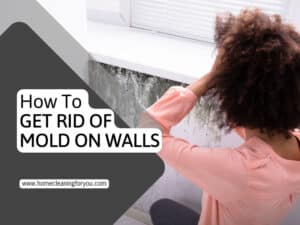Speedy & Simple Ways to Remove Basement Mold Forever
Basements are often neglected hence prone to getting affected by mold. If you walked into your basement only to discover unappealing, black spots on the walls, ceiling, or floor, you’re probably dealing with a mold invasion.
While mold can emerge in any part of the home, basements have the most conducive conditions for the fungus to flourish.
Consequently, basement mold can at times be hard to eliminate especially if you are not addressing and rectifyingunderlying issues.
In this informative guide, I give you the deets on how to eliminate basement mold, the equipment required for the job, and how mold reacts to various materials.
This guide will help you tackle your mold problem, help you keep it in check to prevent it from spreading to other parts of the house since that can pose health risks.
Keep reading for effective and simple ways of getting rid of basement mold fast.
What is Mold?

Mold is everywhere around you, both indoors and outdoors. It is basically a fungus and can be white, green, orange, purple, and black. The fungus needs moisture to grow and a surface to spread on.
Mold forms lightweight spores for reproduction that are continuously present in the air and aren’t harmful in small amounts.
When it has ideal growing conditions, mold reproduces extremely fast.
Health Risk of Basement Mold

Mold can cause health issues, especially to children, the elderly, and people with the compromised immune system. The most common health problems caused by mold are respiratory issues, including coughing, wheezing and sore throat.
Further, prolonged mold exposure can lead to headaches, nausea, eye irritation, skin rash, and in severe cases heart, and neurological problems.
Causes of Mold in Your Basement
Basement mold is most often the outcome of moisture source-condensation caused by appliances or leaky foundations.
Therefore, the first step in preventing basement mold is ensuring that the basement doesn’t retain moisture and does not support a humid setting where mold can flourish.
Drying a poor-ventilated basement is difficult, and mold can appear. In simple words, mold spores float in the air and need moisture to reproduce.
There are two common reasons why mold infected in your basement:
- Wet: There are numerous reasons why your basement is wet, water damage or a leaking problem. The foundation walls might be wet because the water might penetrate the porous concrete walls. After water damage in the basement, you can expect the mold to take over the walls and other surfaces in only two days.
- High Humidity: Some people keep the dryer in the basement, which releases the humidity, or the air around the basement is humid, and it has access to the basement.
Whatever the reasons for mold are, you can control it and remove it, but it can be a daunting task. Making mold cleaning part of your regular household cleaning routine can help you sustain it.
Although basement mold is a common issue, understanding how to recognize problem areas and control mold development will help you prevent the detrimental spread of mold.
How to Recognize Mold in Your Basement?
The first sign that you have mold in your basement is the unpleasant musty, almost earthy smell in your basement. It is similar to the wet wood smell. Once you notice the smell, look around places where mold appears.
Mold develops around pipes and vents, in the ceiling, around the dryer, and as it starts growing, it can overtake the wall.
Mold will generally make the area look dirty and speckle sections with black dots or spread in irregular shapes. It can start in dark corners and work its way around to the wall and ceiling.
Mold Or Efflorescence?
If you have never dealt with mold before, you might confuse it with efflorescence, as the two look quite similar.
Efflorescence happens on concrete when moisture goes through the material and absorbs the minerals from the water. Then water evaporates, and the minerals stay on the surfaces, which looks like a white growth.
If you aren’t sure which one is in your basement, you can find out easily.
Sprinkle the growth with water, and if it disappears, it means that the minerals dissolved in the water and you have efflorescence.
If the growth stays on the surface, keep reading to find out how to get rid of it.
Watch this video to know more:
Mold Vs. Mildew
Mildew is also a fungus, similar to mold. It appears in warm and damp areas and is usually grey, whitish, and sometimes yellow. Mildew is easy to clean with a detergent and a scrubbing brush, while mold requires more effort.
You should see the video below:
Materials & Tools To Remove The Mold From Basement
Here is a list of things to prepare when you are ready to tackle the mold problem in your basement:
| Tools | Materials/Ingredients |
| Protective gear – gloves, goggles, respiratory mask | Hydrogen peroxide |
| Spray bottle | Vinegar |
| Sponge | Essential Oils |
| Scrubbing brush | Bleach |
| Bucket with water | Borax |
| Cleaning solution | Baking soda |
Step-by-Step Guide To Get Rid Of Mold In The Basement
Depending on the extent of contamination, you will need to decide whether to get rid of the mold yourself or call in the experts.
No matter how you do it, you need to follow certain precautions, so you should educate yourself on the mold removal process.
This step-by-step guide will walk you through the steps involved in removing mold safely.
Step #1: Use Protective Gear
If you decide to undertake a DIY approach, you’ll need protective gear. At the minimum, you should wear goggles, rubber gloves, and a face mask. Depending on the extent of the manifestation, you might even need a bodysuit.

You must decrease your exposure to mold spores, particularly if you have a compromised immune system or allergies.
It’s equally important to note that mold exposure can aggravate the symptoms of asthma or lung diseases. It can also cause respiratory issues. For this reason, you must prioritize safety.
Step #2: Ventilate the Area
You need to ventilate the area and remove excess water if there is any. Use a wet dry shop vacuum to remove water and prepare the area.
I recommend turning the HVAC system off while you work to prevent spreading live mold spores throughout the house.
Step #3: Damage Assessment
Performing damage assessment is perhaps the most significant task when eliminating basement mold. An invasive infestation that developed in your absence for a week or two will probably need a mold remediator to tackle the problem.
However, if you discover that the growth is less than 10 sq ft, you can undertake a DIY project and clean it up yourself.
The same applies if you discover mold in small sections generated by a leaky AC or some minor issue. You’ll need to examine the affected sections.
Remember that porous surfaces will typically be harder to clean. You’ll especially have a difficult time in cases where the spores have infiltrated beyond the surface.
Keep in mind that you might need to dispose of ceiling tiles, carpets, and comparable materials. On the same note, you want to avoid harsh solutions, which will only cause further damage.
You can buy an affordable test kit, which incorporates the lab charges as well as a comprehensive report.
Alternatively, a professional contractor could conduct an assessment and issue a comprehensive bid for accomplishing the task. Whichever route you take, it is important to first understand the degree of mold infestation in your basement.
Step #4: Determine the Water Source and Fix the Issue
Before you embark on a mold elimination project, you must first establish the source. Remember, mold needs moisture and darkness to develop. In other words, mold cannot exist without a water source.
Moisture could originate from various places, including a broken pipe within the walls of your home or a hole in the siding that permits the rainwater to penetrate.
If you can’t trace the source of the problem, you might want to engage a specialist or contractor to determine the root cause. The last thing you’d want is to perform expensive repairs only for the mold infestation to recur.
Step #5: Eliminate Infested Carpets
You’ll need to eliminate any mold-infested carpet in your basement. In numerous cases, you’ll discover the fungus has penetrated the carpet’s underlayer. When this occurs, the problem might not be evident, but it’s worse than surface mold.

You’ll need to rip your carpet into segments along with any underlayers before double bagging it for removal from your residence.
You’ll need to pay extra attention when hauling moldy things from your home because spores could easily escape and subsequently spread into other areas, including the kitchen and living room.
Step #6: Remove Infested Wall
This step entails tearing down infested wall. The possible cause of infested wall is rain seeping through your home’s foundation. Many people use a mold killer to spray infected spots hoping this will resolve the issue. At times, this approach might work, particularly if the infestation isn’t severe.

In numerous instances, however; such products, especially bleach, merely change the mold’s color without addressing the problem that lies within the walls. The ideal approach is to take out at least 24 inches of wall patch to examine inside the walls and evaluate the situation.
On evaluation, you may realize that the insulation needs removal or you might stumble upon a hole in the exterior that’s causing leakage into the home. Another significance of eliminating portions of wall and examining inside is that you can evaluate whether there’s any internal damage.
If you find mold on plywood sheeting or wall studs, you can expect their integrity to be compromised. It will just be a matter of time. In such cases, any material with mold on it will need replacement.
Step #7: Clean Up and Dry
After the removal of the moldy wall and carpet, you’ll need to clean up what’s remaining. A solution of water and bleach is suitable for linoleum and concrete surfaces. You shouldn’t use the solution on wood because it might promote mold development.
If you discover considerable mold development on studs or wall, simply discard and substitute them. Once you complete the cleanup, allow the area to dry while ensuring there’s considerable air supply throughout.
Eliminating Mold on Various Materials in the Basement
Mold can develop and flourish on virtually any basement material. Here’s a look at how the fungus affects various materials and how you can get rid of it.
Wood

You’ll find wood in the basement in the form of furniture, wood framing, and various other items. Wood is highly susceptible to mold development because it has pathways in which mold can develop. This should also be a cause of concern because your wooden items might not survive mold.
Plus, if you don’t clean mold on wood framing appropriately, it could progress into a serious and costly affair. After all, if you allow the spread of the fungus on unfinished wood, say for example your wooden floor or ceiling, the material may eventually disintegrate leading to structural issues.
Keep in mind that mold development can remain hidden from view beneath planks, making it difficult to detect.
If mold has affected the furniture in your basement, you will first need to shift them outdoors for better ventilation and faster drying.
Fabrics

Fabrics in the basements can be found in the upholstery of chairs and couches. Remember, fabrics are porous, and this makes them more susceptible to considerable mold contamination.
If your basement has a moisture problem consider moving all fabric-made furniture outdoors in the sun. This will help your furniture air out faster.
Removable fabrics from furniture can easily be tossed in a washing machine to get rid of the mold. However, depending on the extent of damage, I would recommend you to consider replacing the fabric on certain furniture.
Carpets

Carpeting your basement may make it feel cozy and comfortable but from what I’ve seen, it is also risky because basement flooding is always a possibility.
Mold can develop in a carpet the same way as a fabric. If it is not possible to clean it thoroughly you will need to consider taking it out and getting it replaced.
Drywall

Basement flooding can occur for various reasons. If not addressed immediately and correctly it can lead to the formation of mold.
At times, basement mold can occur behind the walls and the foundation. This could cause serious problems since it remains concealed and therefore it may be a while before it is discovered. In the interim, it would have spread fast due to the absence of ventilation.
One way for professionals to establish whether there’s mold developing behind the drywall is by drilling a hole in the wall and inserting a tool for mold testing. If they discover mold, you may have to replace considerable segments of drywall and perhaps some wood framing as well.
HVAC

Basements frequently have HVAC ducts. Make sure you examine the drip pan regularly because if left unchanged for a prolonged period, it can become a breeding ground for basement mold.
Condensation can develop along the interior and exterior of HVAC ducts, offering a source of moisture for mold.
This is especially challenging in the basement segments of the HVAC because the room usually has poor ventilation and condensation doesn’t dry as fast as it should, all favorable factors for the formation of basement mold.
If you notice mold developing on the interior of your system, note that the issue has become serious because mold-contaminated air will spread throughout your home. In this case, I would certainly engage professional services.
Pipes, Drains

A typical basement is the site of numerous pipes and faucets for home systems. They could be associated with various purposes, including a bathroom and basement drainage.
These areas are probable spots for mold development because of minimal ventilation and moisture. Therefore, you should monitor them frequently.
6 Products to Eliminate Basement Mold Naturally
Mold removal from a home’s surfaces can occur in various ways, based on the location and size of the infested area. Unless you want the remediation task done professionally, you can purchase most supplies from your local hardware or home improvement store.
Nevertheless, you might want to hire an inspector before you start tackling it because some organic materials are typically more hazardous than others. It’s worth noting that mold removal from wood differs from eradicating the issue from concrete, so be mindful of the base material you’re working on before applying any kind of cleaning solution.
Similarly, painted walls need special care. After all, you wouldn’t want to damage the surface while attempting to eliminate mold.
Some commonly used products for mold removal are:
Hydrogen Peroxide
You probably have this effective and versatile cleaner in your medicine cabinet. It might surprise you to discover that hydrogen peroxide isn’t merely an antifungal and anti-bacterial solution.
Rather, it’s safe for mold removal on various surfaces, for instance, kitchen appliances and even wall surfaces in the basement.
To destroy mold on concrete basement walls, you’ll need 3% of the cleaner in a spray bottle. Consider testing an inconspicuous surface area first to avoid damage or discoloration. Once you’re certain, you can saturate the walls with the solution and allow it to sit for about 30 minutes.
You’ll need a bristle brush to remove mold off the walls by scrubbing the affected area thoroughly for approximately 10 minutes to lift any mold from the concrete.
If possible, consider using a hose or scrubbing the walls with warm water to eradicate water spots that are likely to promote further mold growth.
Watch this video to know more:
Borax

While it isn’t as non-toxic as other solutions, it’s a better substitute than potent chemical solutions. The effective cleaner is recognized for its deodorizing and cleansing properties. Since the cleaner works to inhibit mold development, it is excellent for mold removal from large areas.
You won’t even need to clean off the solution once you’re done. To use this approach, combine a cup of the cleaner with a gallon of water and apply it to the fungus.
You should scrub the surface using a sponge or a scrub brush to eliminate visible particles and allow the solution to settle on the surface for some time.
Baking Soda

From odor absorption to heartburn alleviation, baking soda has various uses around the home, including coming in handy for mold removal. The safe cleaner doesn’t merely destroy black mold. It absorbs moisture, which is the primary cause of mold development.
Add ¼ tablespoon of the cleaner to a spray bottle and shake the bottle until it dissolves. Spray the solution onto the moldy area and remove any surface mold with a scrub brush.
Subsequently, use water to rinse the surface to eliminate any residue of baking soda and mold. Lastly, you’ll re-spray the area and allow the surface to dry naturally. This will destroy any persisting mold and prevent them from recurring in the future.
For tough removal, combine 1-part white vinegar and two parts baking soda. Stir the combination until it thickens into a paste. Then proceed to spread the mixture generously onto the surface and allow it to dry.
Finish by scrubbing the mold and any accompanying stains before wiping down with water.
Bleach
Besides being a great disinfectant, bleach can equally function as a mold killer. The only problem is that it’s not effective on porous surfaces. Since it does not infiltrate surfaces well, it is not as effective on drywall or concrete.
Nevertheless, it is effective on sealed surfaces. You’ll need to dilute bleach, approximately a cup, with at least a gallon of water.
You can wipe or spray the solution onto any mold-covered surfaces in your basement. It’s worth noting that bleach functions effectively on non-porous surfaces such as sealed tiles.
When working with the solution, ensure you wear protective gear, for instance, eye protection and rubber gloves, particularly in poorly ventilated areas such as a basement. Never combine bleach with ammonia or vinegar.
Vinegar
The mildly acidic component disinfects, cleans, and destroys mold on non-porous and porous surfaces. A major advantage of this ingredient is that it’s safe for use on most surfaces and the odor disappears fast.
Ensure that the white vinegar being used is undiluted. Since white vinegar comprises about 20% acetic acid, you don’t want to dilute it with water, decreasing its efficiency.
Spray the solution onto the affected surface and leave it for one hour. Complete the process by wiping the area with water and permit it to dry. Any smell emanating from the vinegar will clear within a couple of hours.
Beware that vinegar doesn’t destroy all mold types, so research a small segment first. Alternatively, you could spray a mixture of water and baking soda onto vinegar-saturated spots to enhance the mold-destroying potency. To complete the task, use water to wipe the surface.
You should see the video below:
Essential Oils
While essential oils are commonly associated with aromatherapy, they have various other uses. In addition to being an antiseptic and insect repellant, the compound is one of the safest for eliminating black mold. The natural fungicide cleans up mold fast and helps prevent spores from recurring.
Mix a teaspoon of the compound with a cup of water in a bottle and shake the mixture thoroughly. Spray the mold-affected area and allow it to dry for at least an hour before wiping with a dry towel or microfiber cloth.
In case of skin sensitivity, ensure you wear gloves. The following essential oils or natural ingredients work wonders when it comes to mold removal:
Tea Tree Oil
Surprisingly, tea tree oil is efficient at killing mildew and mold on various surfaces, including basement walls. If you’re seeking a healthy method of killing mold, this might just be what you need.
If the area you’re cleaning has visible mold, you might want to use a rag or sponge soaked in the solution. In both instances, allow the cleaner to remain on the surface and don’t rinse. This will prevent future mold development.
You want to be cautious when using this cleaner especially if you’re a pet owner.
Lemons
While lemons work as an antiseptic, natural deodorizer, cleaner, and stain remover, they can eliminate black mold as well. Lemon has a high acid concentration, which breaks down mold, allowing easy removal while leaving a disinfected surface.
Take 3-5 lemons and juice into a cup before pouring onto the mold-affected spots. Allow it to sit for about five minutes and wipe the surface using a damp towel. For tough stains, consider reapplying and scrubbing the surface for mold elimination.
The aforementioned natural remedies are excellent non-toxic substitutes for chemical-based mold removers and several are equally efficient against mildew. Furthermore, they’re safe for use besides being environmentally friendly and more affordable than commercial brands.
The video below should be able to help you:
How to Remove Mold From Painted Walls?
Even though bleach is effective against mold on the walls, you should stay away if the walls in your basement are painted. The bleach will cause the paint to fade.
Instead, you can use borax and vinegar methods as safe methods for cleaning mold from painted walls. But, you might need to repeat the process several times to remove mold spores completely.
Also, make sure to use a brush with soft nylon bristles or a sponge instead of a metal one to avoid scratching the surface. Additionally, brush with metal bristles can rust and stain your walls.
Watch this video to know more:
How to Prevent the Mold from Growing in Your Basement?
Humidity is the reason number one for mold growth. To deal with it, you should do a couple of steps to keep it under control and on a safe level to prevent mold development.
How to Measure Humidity?
A hygrometer is a tool people use to identify the levels of humidity in rooms. There are different models on the market, and most of them are quite affordable and available in stores and online.
Condensation is a visual sign that the humidity in your basement is high, but a hygrometer is the only way to get precise measurements.

What is Optimal Humidity for a Basement?
Humidity in the basement shouldn’t be different from what you consider comfortable for your rooms. The optimal humidity for the basement is between 40% and 60%.
During different seasons humidity varies, and you should measure it several times to get the average values.
How to Control Humidity in the Basement?
There are several ways to decrease the humidity level in your basement and maintain an optimal level. Here are some ways:
Dehumidifiers
Dehumidifiers are household appliances designed to lower humidity. They can work exceptionally well if you choose the model that is suitable for the size of your basement. It can lower the humidity from 90% to 50% in several days.
You can choose between different types, from large industrial dehumidifiers that require a draining system, to small and portable models with removable water tanks.
Installing a Ventilation System
The ventilation system will improve the airflow in the basement, which can reduce humidity. You can connect the basement to your HVAC system, or buy an A/C unit for the area. If your basement is small, you might get good results with fans, too.
Insulation
Insulation is useful for people who live in hot and humid climates because it prevents warm air and water vapor from penetrating your basement through cracks.
You can also consider insulating pipes, as cold pipes condensate in summer, which leads to high humidity. It will also protect hot water pipes from freezing during cold temperatures.
Control the Leaks
Lastly, if you suspect that the humidity is causing mold in your basement, inspect it for leaks. If you find puddles or small leakage issues, deal with the problem immediately and dry the area as soon as possible.
When is the Time to Call for Professional Help?
If your basement has a severe mold infestation, you might want to consider professional assistance. This is because black mold, in particular, can be dangerous if inhaled in huge quantities. If the mold issue is extremely severe, removal specialists might opt to fumigate to eliminate the infestation.
Whichever approach they take to address the issue, you can be confident that they’ll carry out a thorough job to prevent a recurring mold problem. The failure to eliminate the moisture source that produced the mold will result in increased mold development.
On the other hand, an expert will eliminate all spores from an infestation to prevent the same colony from growing back in a similar area.
Mold is Annoying but Treatable
Household mold is a common basement invader, particularly in the presence of sump pumps or water damage. Even exterior walls and air conditioners aren’t impermeable to mold infestation.
That’s why it’s vital to establish how to eliminate basement mold. You just need the appropriate removal methods and cleaning products. This will make the process straightforward and easy.
You’re probably among many homeowners who’ve just discovered basement mold but don’t know where to start. Ignoring the issue will only make it worse leading to further problems.
Sharing this post will enlighten others on this topic. Feel free to like it, leave feedback, and share your opinions on the subject matter.






Kevin Jones
Founder & Chief Home Organization Strategist
Expertise
Home Organization & Decluttering, Efficient Cleaning Methods & Stain Removal, Sustainable Cleaning Practices, DIY Home Maintenance & Repairs, Space Optimization & Storage Solutions, Budget-Friendly Home Care Strategies
Education
University of Texas at Austin
Kevin Jones is the Founder and Chief Home Organization Strategist at HomeCleaningForYou.com.
He earned a Bachelor of Science in Interior Design from the University of Texas at Austin, focusing on space planning and sustainable design. Specializing in home organization, decluttering, and budget-friendly home care, he helps homeowners create functional and stylish spaces.
Kevin has been featured in lifestyle publications and has collaborated with eco-friendly brands on home organization solutions. He shares his expertise through DIY guides, workshops, and online tutorials. Passionate about minimalism, he enjoys testing new organization methods and exploring sustainable living ideas.